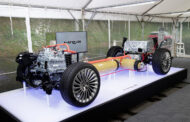Toyota Motor Corporation has developed what the company claims is the world’s first integrally molded FLAD substrate, a new lighter catalyst that uses 20 per cent less precious metal in 20 per cent less volume while exhibiting the same capacity for exhaust gas purification. The catalyst has been designed in such a manner that the inner portion has a different cross-sectional area when compared to the outer portion. The company developed innovative design and manufacturing technologies for commercial production of the new catalyst. The catalyst will be gradually installed in new vehicle models, beginning with the Lexus LC 500h that will be launched later this year. The use of greater quantity of catalytic precious metals for cleaning exhaust emissions and reducing air pollution issues lead to a whole set of new issues including higher costs and resource depletion.
Toyota conducted extensive research to come up with solutions for enhancing the purification efficiency of catalytic precious metals, like finding the optimal shape and length for the substrate, and modifying the cell wall thickness and cross-sectional area. Other efforts in this direction included selectively washcoating precious metals and other catalytic materials, and changing the density of the catalytic substrate cell to align with exhaust gas flows.
Toyota collaborated closely with its supplier Denso Corporation to develop the new FLAD substrate to improve the uniformity of exhaust gas flow. Both companies worked closely on conducting a series of validations using simulations and prototype substrates, in order to improve the uniformity of exhaust gas flow within the catalyst. This was done by optimizing factors like the ratios of cross-sectional areas of cells at the inner and outer portions, and their corresponding densities. In the new compact catalyst, approximately 20% less precious metal and it contains approximately 20% less volume. The efficacy of exhaust gas purification is the same as that of conventional catalysts.
Currently, the substrate that is most commonly used in exhaust gas purifying catalysts for petrol engines is made of ceramic (cordierite). This uses a honeycomb like structure comprising square or hexagonal cells. The walls of cells within this substrate are washcoated with catalytic materials including precious metals like platinum, rhodium, palladium. The use of these metals provide a catalytic effect, and through oxidation-reduction, toxic gases like carbon monoxide, unburned hydrocarbons, and nitrogen oxide (NOx) are purified with the exhaust system to make them safe.
Toyota has thus succeeded in mass producing this new substrate with the world’s first design and manufacturing technology that is able to integrally mold the catalyst.






















